Building an RV park is a complex process that requires careful planning and significant capital investment. The cost to build an rv park can vary greatly depending on several factors, including location, size, amenities, and infrastructure requirements.

In this comprehensive guide, we will explore the different costs involved in building an RV park, allowing you to prepare and budget for your project effectively.
cost to build an rv park
The cost to build an RV park can vary depending on factors such as location, size, amenities, and infrastructure requirements. Generally, the cost can range from $10,000 to over $1 million.
The largest cost component of building an RV park is infrastructure development, including water, sewer, electrical, cable, Wi-Fi, and other utilities for each campsite.
On average, infrastructure development costs can range from $5,000 to $20,000 per campsite. Land acquisition and site preparation can also significantly add to the costs, with land acquisition averaging around $20,000 to $80,000 per site and site preparation costing anywhere from $10,000 to $100,000 or more.
Amenities and legal and administrative costs are additional factors to consider, with costs varying depending on location and specific needs. It’s important to budget carefully and work with experienced professionals to ensure a successful project.
Understanding the Costs
Land Acquisition
The cost of purchasing land for an RV park can vary significantly depending on the location, local property values, and availability.
The size of the land you need will depend on the number of campsites you plan to have and any additional amenities you wish to include. According to RV Park Consulting firm CPM Real Estate, the average cost per site for land acquisition is around $20,000 to $80,000.
Site Preparation
After acquiring the land, the next step is site preparation. Site preparation costs include grading, trenching, and paving necessary for developing the campsites and infrastructure.
Some other site preparation costs include permits, surveys, environmental studies, and other necessary documentation. Depending on the size of your RV park and its requirements, site preparation can cost anywhere from $10,000 to $100,000 or more.
Infrastructure Development
Infrastructure development is one of the most crucial components of building an RV park. The infrastructure includes water, sewer, electrical, cable & Wi-Fi, and other utilities required for each campsite.
These infrastructure requirements can be costly, and their costs vary depending on the local pricing and the size of the RV park. On average, infrastructure development costs can range from $5,000 to $20,000 per campsite.
Campsite Development
A significant cost associated with building an RV park is creating the actual campsites. The cost of campsite development varies based on the level of amenities and infrastructure provided such as water, electricity, cable, Wi-Fi, and sewage.
On average, campsites cost around $2,000 to upwards of $10,000, depending on the specific amenities, such as concrete pads or gravel.
Amenities
Amenities such as swimming pools, playgrounds, dog parks, and laundry facilities, can be significant selling points for an RV park. These amenities also add to the cost of the park.
The average cost of developing amenities can vary greatly, but most amenities are generally priced between $25,000 and $100,000.
Legal and Administrative Costs
There are many legal and administrative costs associated with building and operating an RV park, including permits, licenses, zoning, and other regulatory requirements.
The cost of legal and administrative costs varies depending on several factors such as the location, size of the park, and specific regulatory requirements in the area.
You may also find interesting: How to Make Oxygen Absorbers For Food Storage
Understanding the Operating Costs of an RV Park
Operating an RV park requires careful financial planning to understand and budget for the ongoing expenses involved in running and maintaining the facility.
In this guide, we will delve into the various operating costs associated with an RV park, including utilities, maintenance, staff wages, insurance, and marketing costs.
Understanding these expenses will help you effectively manage and budget for the day-to-day operations of your RV park.

Utilities
Utilities are a significant operating expense for an RV park. These include electricity, water, sewer, garbage disposal, and potentially cable TV and Wi-Fi.
The cost will depend on factors such as the size of the park, the number of campsites, and the local utility rates. On average, utilities account for about 20% to 30% of the overall operating costs of an RV park.
Maintenance and Repairs
Maintaining an RV park is crucial to ensure a clean and pleasant environment for guests. This expense includes regular maintenance of facilities, such as roads, landscaping, common areas, and amenities.
It also covers repairs and replacements for equipment, facilities, and utilities. The cost for maintenance and repairs vary depending on the age and condition of the park and the specific amenities offered.
Staff Wages
Employing a dedicated staff is necessary for the day-to-day operations of an RV park. The number of staff members required will depend on the size and services offered at the park.
Staff wages typically include salaries for managers, maintenance personnel, housekeeping staff, and potentially security personnel. The labor costs can vary significantly depending on the park’s location, the number of staff members, and their qualifications.
Insurance
Insurance coverage is essential to protect the RV park from liability and property damage risks. The cost of insurance will largely depend on factors such as the size of the park, amenities offered, the number of guests, and the park’s location.
Insurance coverage should include general liability, property insurance, workers’ compensation, and potentially additional coverages like umbrella liability or environmental liability.
Marketing and Advertising
Marketing and advertising costs are essential for attracting guests to the RV park. This expense includes website development and maintenance, online advertising, print materials, photography, and promotional activities.
The budget for marketing and advertising will depend on the park’s target market and its desired reach. Understanding the operating costs of an RV park is crucial for effective financial planning and management.
Utilities, maintenance, staff wages, insurance, and marketing costs are important components of the ongoing expenses associated with running and maintaining an RV park. By carefully analyzing and budgeting for these costs, RV park owners and operators can ensure the smooth and successful operation of their facility.
Assessing the ROI and Profitability of an RV Park
Investing in an RV park can be a lucrative venture, but it is essential to evaluate its potential return on investment (ROI) and profitability.
In this guide, we will investigate the key factors that impact the financial success of an RV park, including occupancy rates, average daily rates, and seasonal fluctuations.
By understanding these factors, investors can make informed decisions and create strategies to maximize ROI and profitability.

Occupancy Rates
Occupancy rates play a significant role in determining the profitability of an RV park. It refers to the percentage of available campsites that are occupied by guests during a specific period. Higher occupancy rates indicate a greater demand for the park’s services and can lead to increased revenue.
A well-managed RV park typically aims for occupancy rates above 50%. However, factors such as location, amenities, marketing efforts, and competition can influence occupancy rates.
Average Daily Rates
The average daily rate (ADR) is another critical factor in determining the profitability of an RV park. It represents the average price charged per campsite per night.
A higher ADR can contribute to higher revenue, while a lower ADR may attract more guests but result in lower overall income. Setting the right ADR involves finding a balance between attracting guests and maximizing profit.
Factors to consider when determining the ADR include market rates, local competition, park amenities, and the expected level of demand.
Seasonal Fluctuations
Seasonal fluctuations are common in the RV park industry, with peak season and off-peak season demand varying significantly. Understanding these fluctuations is crucial for maximizing profitability.
In popular vacation destinations, the peak season may coincide with the summer months or holidays, while in colder climates, it may be during the warmer months.
It is important to carefully analyze historical data and market trends to forecast and plan for seasonal fluctuations. During the off-peak season, implementing strategies such as reduced rates, promotions, or targeting specific customer segments can help increase occupancy levels and maintain revenue.
Additional Factors Affecting ROI and Profitability
- Operating Expenses: Managing operating expenses is crucial for maintaining profitability. These include utilities, maintenance costs, staff wages, insurance premiums, marketing expenses, and property taxes. Efficiencies in operations and cost control measures can significantly impact the bottom line.
- Park Amenities and Services: The quality and variety of amenities offered by an RV park can influence both occupancy rates and ADR. Popular amenities may include swimming pools, laundry facilities, playgrounds, Wi-Fi, cable TV, and on-site recreational activities. Assessing the demand for these amenities and offering desirable services can help attract and retain customers, leading to increased profitability.
- Market Competition: The intensity of competition and market saturation in the RV park industry can directly affect the ROI and profitability of a park. Analyzing the local market, understanding competitors’ offerings, and identifying ways to differentiate the RV park can help capture a higher market share and maintain steady revenue.
Evaluating the ROI and profitability of an RV park involves careful analysis of factors such as occupancy rates, average daily rates, and seasonal fluctuations.
A comprehensive understanding of these factors, along with consideration of operating expenses, park amenities, and market competition, is essential for making informed investment decisions and developing strategies for long-term success.
By effectively managing these variables, investors can optimize their ROI and profitability in the RV park industry.
Conclusion:
Building an RV park can be an excellent investment, but it requires significant capital investment and careful planning.
The cost of building an RV park depends on several factors, including land acquisition, site preparation, infrastructure development, campsite development, and amenities.
It’s important to do thorough research, prepare a detailed budget, and work with experienced professionals to ensure a successful project. By understanding the costs involved, you can make informed decisions and budget appropriately for your RV park construction.


